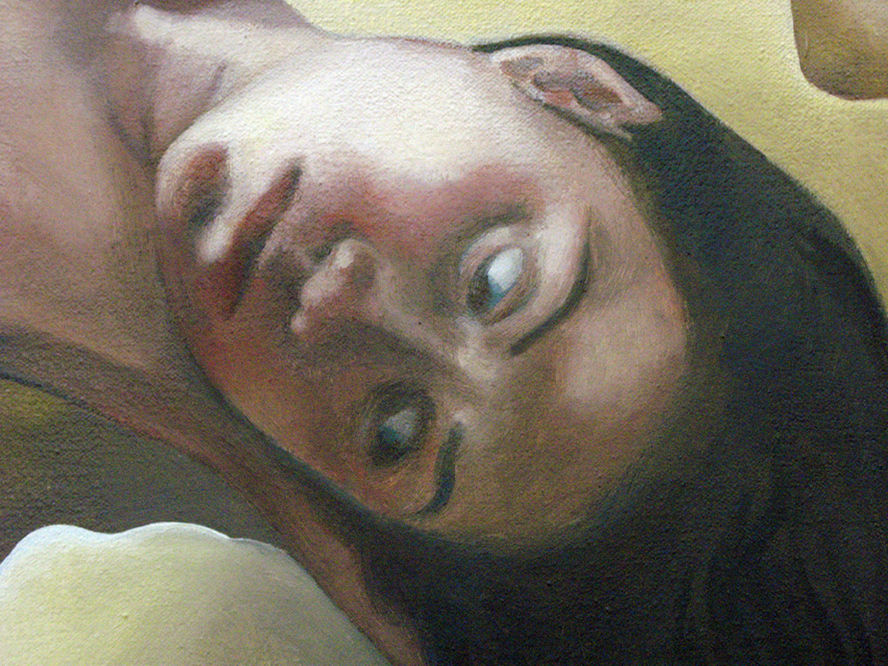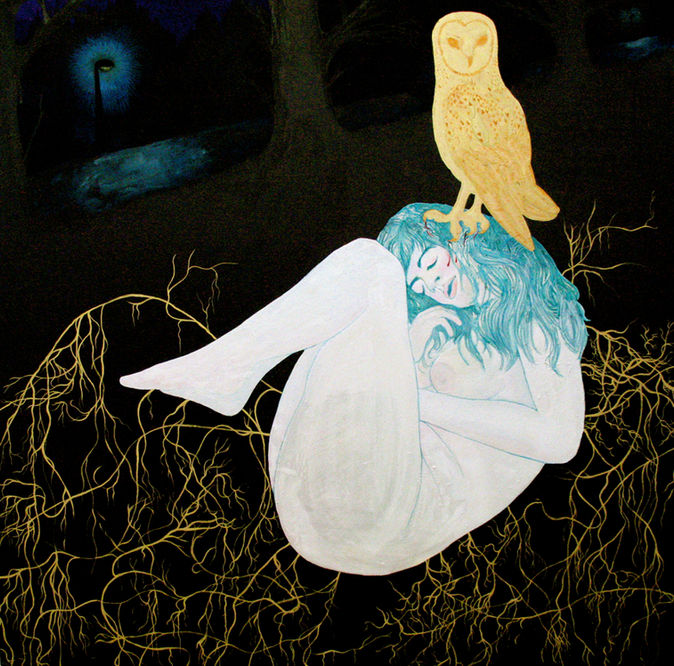MYTHOS
The aim this work is to return painting to its original historical objectives: to make tangible the most fundamental human beliefs by illuminating ancient mythology. World myths are rich grounds for gleaming truths of the human condition. They offer visual narratives to emotional and spiritual experiences that transcend words, and speak to the universality of certain human phenomenon, while the mythology of a specific country acts as a window to the mores and taboos of that culture. My work has focused on mythological narratives that deal with themes of transformation and change: stories in which the protagonist moves from one state of being to another. I draw inspiration from a wide range of cultural sources, but have been particularly interested in Japanese folklore, and have illustrated scenes from various tales as a way of under standing Japanese culture on a deeper level.
On Mythology 神話
The customs, mores, taboos, fears, goals, struggles, successes, and histories of any given culture can be unearthed by the study of its mythology. Myths run deep through our species, like blood through veins; they tie us together and set us apart from each other. It is through the act of perpetuating myth that our Gods are created/discovered. A culture that knows predominately war, death and famine will create myths that reflect these truths. Additionally, a people that know freedom and prosperity will tell stories of love, art and sex; myths are a window to the id, to the deepest psychological state of a people. It is through the act of telling, printing or illustrating myths that we continue their dynamic existence, and in doing so, add our own personal history to that of a greater origin: the history of humanity.
I have come to know some of the ancient myths of Japan and the artwork that they have inspired. I wish to lend a hand to their continued existence, and also use them to further understand my own personal mythology. When I say personal mythology, I am talking about a set of narratives that an individual uses to better understand, explain, archive, and share the story of their own life. In this way, world mythologies can be understood as the macrocosm, the stories that illuminate the soul of a cultural group, whereas a personal mythology is the microcosm, the expression of a personal life history and the experiences surrounding it. The question then arises as to what differentiates everyday anecdotal experiences from a personal mythology. To answer this we must refer to the definition of the word mythology as an allegorical narrative. It is the use of metaphor to understand deep-rooted truths, ideas and experiences that are not easily defined, which implies myth. Some moments of our lives transcend words, and can only be glimpsed through the act of following a narrative and taking on the role of the protagonist as they experience situations that act as symbols for greater emotional or moral truths. Personal mythology is therefore the narratives a person verbalizes, writes or illustrates that use allegory and metaphor to express certain life long transcendental truths as experienced by an individual, and differs from world mythology in that they do not require the acknowledgement of society at large, but are used to understand an express ones own life.
Jungian theory recognizes the existence of archetypes, or “collectively inherited unconscious ideas, pattern of thoughts, images, etc., universally present in individual psyches.” (Dictionary.com, http://dictionary.reference.com/browse/archetype) These archetypes can include both fundamental moments in a person’s life, such as birth, death, separation from parents, marriage, etc., or archetypal figures such as the mother, the father, the child, the hero, the God, the trickster, the wise elder, etc. Jung also acknowledges the existence of totems, natural objects or phenomenon, both animate and inanimate, such as animals, birds, rocks, trees, that act as symbols to represent a group of people or an, often venerated, idea. Totems play an integral role in Canadian ancient mythology and I feel they also have a predominant place in Japanese myths. Through the use of archetypes, totems, icons, symbolism and metaphor we find ways to explain common realities that we share with members of our culture and humanity in general. These same tools of mythos are used to create a personal mythology. To fully understand the characters and outcomes in a mythological narrative, once must remember to weigh their symbolic meaning.
Myths have long been the predominant fodder in the history of visual representation, and in turn, the visual arts have been essential to the perpetuation of myths worldwide. Just as symbolic narrative is used in myth to explain complex emotions and ideas that cannot be simply summed up with words, visual art transcends language altogether and offers an opportunity for individuals to access deeper physiological and cultural truths in myth. From its very birth in the caves of Lascaux, visual representation, in this case painting, has never been limited by the restraints of visual reality. Some of the earliest works of art ever created by the human species are considered to be highly symbolic in nature, more so than representational. From that moment onward, the role of art had been largely to glorify and celebrate the stories of our cultures. Take a random example of art from almost any country at any moment in history and we will see Jung’s archetypes again and again. In ancient Egypt, Greece, Byzantium, during the Italian renaissance and the resulting styles in European art, in tribal African art, Middle American art, in ancient Japan and China, we find death, birth, marriage, coming of age, the mother, the father, the child, the hero, the wise elder, the God, and so on. Arguably, the historical purpose of art is to perpetuate myth, and in doing so, express the soul of a culture.
Only in very recent times has the goal of art been to glorify the experiences of the individual, separate from those of society as a whole. We can see this trend in its infancy during the Italian Renaissance, when artists began to sign their own work, showing a shift in their creative role. For the first time, they were no longer simply perpetuators of culture, but creators, and in a sense, demigods themselves. This idea snowballed to create the art world we have around us today, where the individual voice of an artist supersedes all other considerations of their work. Though artwork is still broken down and classified into styles, types and media, this is done predominantly as a way to understand art today, rather than to rank it. Pieces of artwork are not judged individually, but instead as a part of a body of work belonging to a certain artist. Within the lifespan of an artist there is, to a certain degree, an expectation of evolution and change in the subject matter and material that an individual uses to express their own ideas, or as it were, their personal mythology. I feel very fortunate to be working at this moment in history. I have at my disposal the entire history of human mythos, and the freedom as an artist to do what I will with it.
I approach my own studio practice with these considerations of world mythology vs. personal mythology. As previously mentioned, I have come into contact with the traditions and stories of Japan. It feels only appropriate that as a working artist in Kyoto I should recognize and furthermore be inspired by the myths of this land. Japan, being a polytheistic culture, has a particularly rich collection of Gods, Goddesses, demigods, demons, ghosts, monsters and other supernatural creatures to draw from. Many of these beings reflect Jungian archetypes and totems that also exist in Canada, which speaks to the universality of the human condition. However, the apparitions that I find most intriguing are those that are unique to Japan. By studying and drawing the unique characters of Japanese myth, I expand my working vocabulary of symbols that I can use to better understand my own life. By reproducing Japanese myth in my artwork, I add to its history, and in turn, it adds to my personal mythology.
- Chris Cowan 2009























